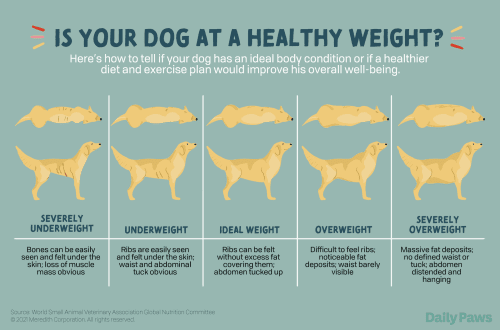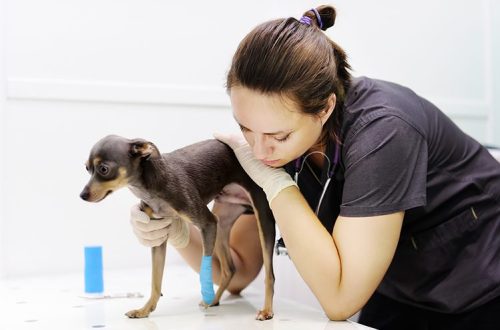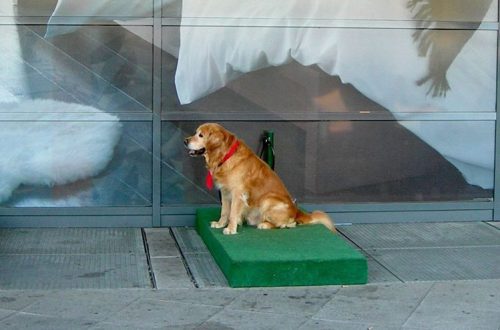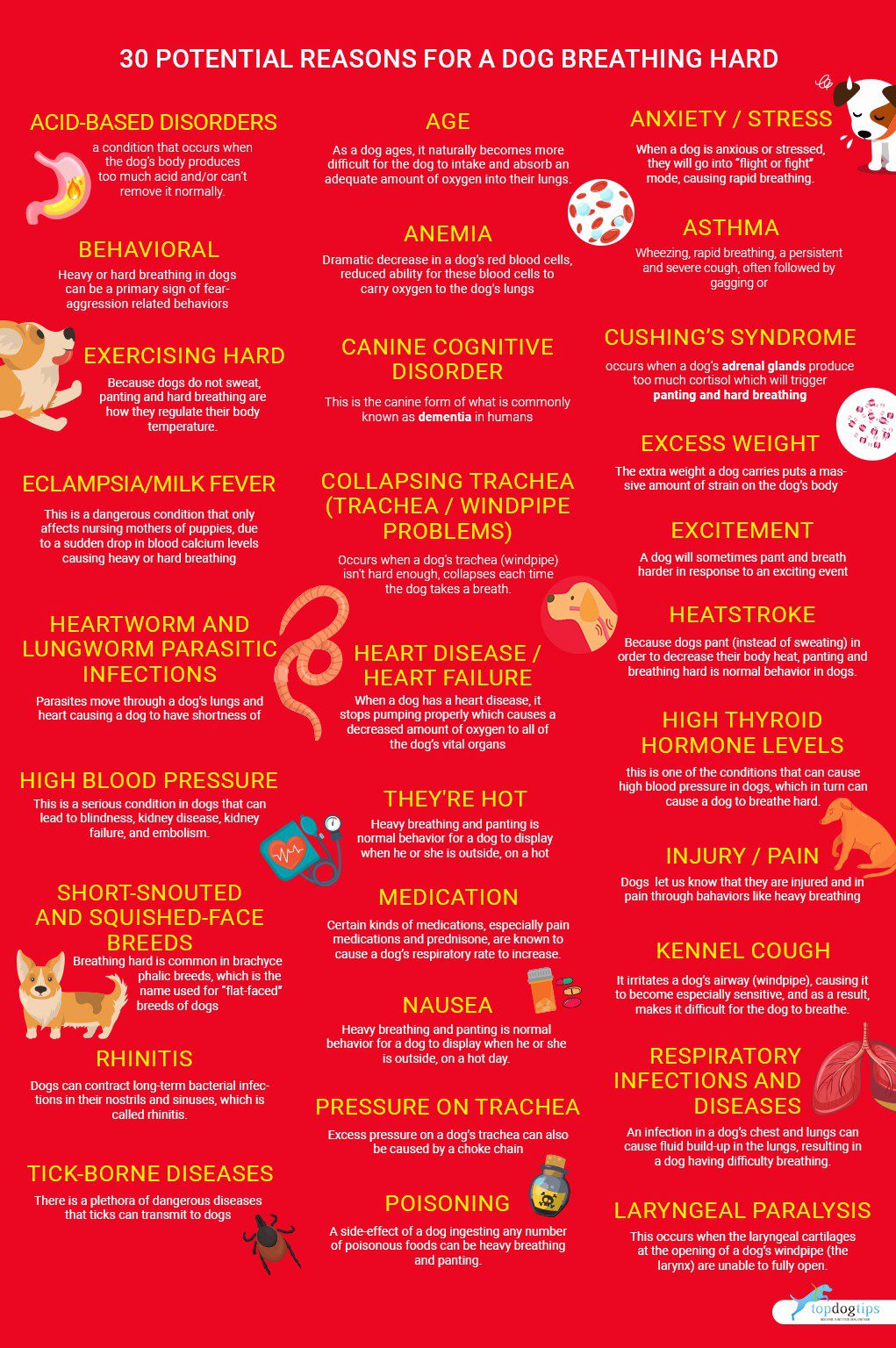
The dog breathes often and heavily – why and what to do?

Contents
Rapid breathing in a dog is the main thing
The causes of rapid breathing or shortness of breath in dogs can be very diverse – from simple overheating or fatigue after exercise to brain injury or anemia due to an infectious disease.
Normally, dogs take 10 to 30 breaths per minute; small breed dogs can do this more often. Therefore, it is important to know the individual breathing patterns of your pet.
The dog breathes frequently in the face of fever or stress, watering, applying a damp towel, and creating a calm atmosphere can help.
It is absolutely not necessary to give your pet cold water in case of overheating. Also, you should not put it in a cold bath, as a vasospasm can occur from a sharp hypothermia of the body and, as a result, its condition will only worsen.
If simple measures do not lead to success, or if you suspect a serious illness, you should immediately contact your veterinarian.
Normal breathing in dogs
The respiratory system in dogs is represented by the upper respiratory tract (nostrils, nasal passages, larynx, trachea, bronchi) and, directly, the lungs. The process of inhalation and exhalation is carried out due to contractions of the muscles of the diaphragm and the muscles of the chest. The frequency of respiratory movements is regulated by the nervous system, which is influenced by the amount of carbon dioxide and oxygen in the blood. The normal respiratory rate (RR) in a dog is measured at rest and is normally between 10 and 30 breaths per minute in dogs.
Next, we will look at why a dog can breathe quickly and quickly.
Dangerous causes of rapid breathing in dogs
Heatstroke
This is a lethal overheating of the dog’s body. Due to the high ambient temperature, the dog’s temperature rises sharply, she has a rapid heartbeat, shortness of breath, and fainting may occur. Without help, the dog will die. In this case, it is important to lower the body temperature as soon as possible, while not doing it very abruptly. Otherwise, due to sudden changes in body temperature, you can plunge your pet into a state of shock.
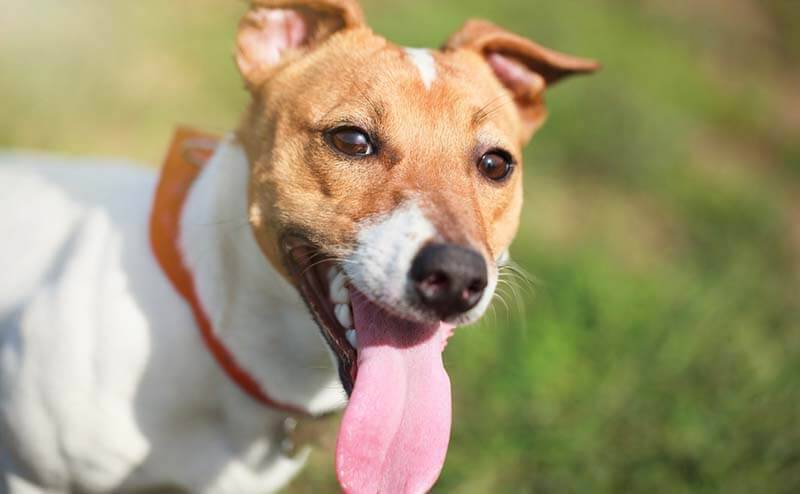
Collapse of the trachea
A common disease of small breed dogs – Spitz, Yorkies, pugs, toy terriers. The trachea is made up of cartilaginous rings that normally maintain a constant diameter and allow air to easily pass from the nasal cavity to the lungs. In some dogs, the cartilage becomes elastic with age, and the tracheal rings collapse, reducing its lumen. Because of this, it is more difficult for a dog to capture the amount of air necessary to saturate the lungs with one breath. Subsequently, chronic inflammation of the bronchi develops, and attacks of shortness of breath appear.
Pneumonia
Inflammation of lung tissue. Pneumonia is infectious and aspiration. When infectious – bacteria or viruses penetrate into the cells of the lung. When they die, they damage tissues. And the more cells die, the less oxygen enters the blood. With aspiration, the same process occurs, but the cells die due to an external physical factor – water, gas, food. The dog develops shortness of breath, the temperature rises, and cough is rarely manifested.
Foreign body in the upper respiratory tract or esophagus
Foreign bodies enter the respiratory tract at the time of deep inspiration. If the foreign body does not clear itself when coughing or sneezing, the animal develops shortness of breath. Symptoms develop very quickly and require immediate medical attention.
Eclampsia
In a lactating dog, a large amount of calcium is excreted with milk. If the dog does not receive adequate nutrition for pregnant and lactating women, the cause of rapid breathing can be an acute lack of calcium in the blood. The disease develops during pregnancy or in the first days after childbirth. Shortness of breath appears, the temperature rises, in severe cases, muscle tremor develops and convulsions appear.
Heart Disease
Any heart failure leads to a slowdown in blood flow and, as a result, to a decrease in its access to organs. Due to congestion, fluid may escape into the chest or abdominal cavity, which will cause squeezing of the organs and shortness of breath. Yes, and without squeezing, due to the slow speed of blood flow, the dog’s organs are in a state of oxygen starvation, the body tries to compensate for this by speeding up breathing. As a rule, under such conditions, the dog wheezes and breathes heavily, it has little interest in the environment, lies down and does not eat.
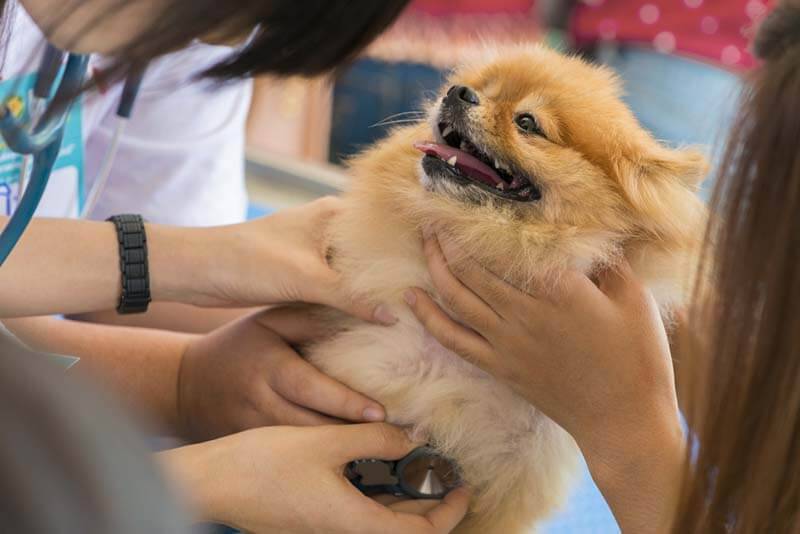
Neoplasms of the chest
The main cause of heavy breathing in older dogs can be tumors of the chest cavity of various etiologies. They can spread through the tissues of the lungs, grow independently, without affecting the tissues of other organs. At the same time, they change the anatomy, as a result of which it is difficult for the lungs to perform their function.
Non-dangerous reasons
High ambient temperature
Overheating is the most common and, in most cases, non-dangerous cause of rapid breathing in a dog. Of course, this does not include solar and heat stroke. Rapid short breathing with tongue hanging out is a way for a dog to lower its body temperature when it is hot. The dog increases the heat dissipation of his body by evaporating fluid from his protruding tongue and gums.
Specificity of the breed
Dogs with an anatomically short muzzle, or brachiocephalic, breathe frequently and are at rest. Brachycephals include pugs, bulldogs, Pekingese, Shih Tzu. The peculiarity of these breeds is that their skull is very short, the nostrils are narrow, and the soft palate is long. Because of this, in order to fill the lungs with air, they have to take stronger and more frequent breaths.
Nervous excitement
Rapid breathing as a result of stress is common in excitable dogs. Often small breeds suffer from this problem – Spitz, Yorkshire Terriers, Toy Terriers. To start to get nervous, as a result of which shortness of breath would develop, a tremor would appear, the animal would begin to whine and breathe rapidly, a little stress is enough.

Pregnancy and childbirth
A pregnant dog may periodically experience rapid breathing, since an interesting position is a load on the body. And the longer the period, the harder it is for the dog to move, lie down and do the usual things. Just before giving birth, the pet may experience pain and stress, which also causes shortness of breath. However, after childbirth, the condition should return to normal, and breathing should return to normal. If this does not happen, pay attention to the pathological causes of shortness of breath given in this article and contact your veterinarian.
colorful dreams
Interesting fact, dogs also dream. It has been scientifically proven that dogs have dreams similar to those of humans. For example, an animal can see a joyful dream, where he got a delicious bone. Or, on the contrary, a frightening dream with chases and fears, because of which the pet will actively move, whine and breathe often.
Concomitant symptoms
Shortness of breath is only a symptom of the disease, and, of course, with diseases of the heart and lungs, other symptoms also appear. Let’s take a look at the most common ones.
Cardiopalmus
The norm of heart rate at rest in an adult dog is 70-120 beats per minute, in puppies – up to 220. You can also measure your pulse at home. To do this, feel for a pulsating vessel on the inner side of the dog’s thigh and count the number of strokes, like a person on the wrist. Heart palpitations can occur with pathologies of the heart or overheating.
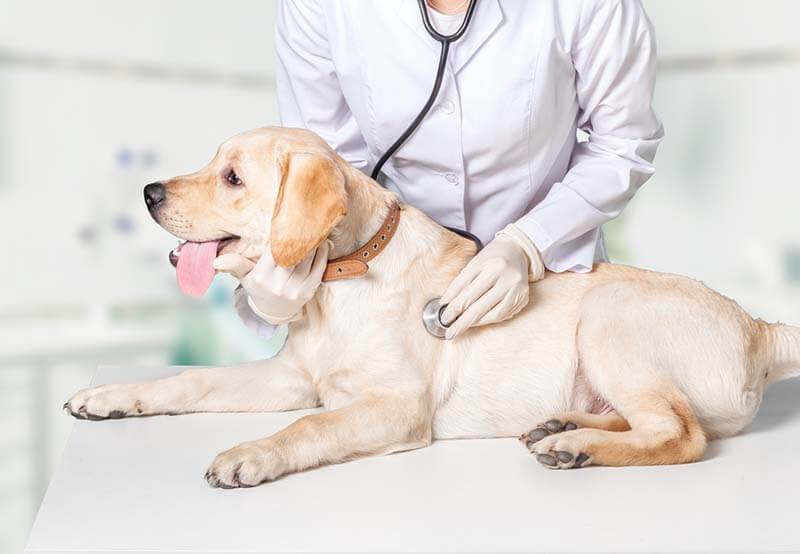
Wheezing
Pathological noise that occurs when inhaling or exhaling. Most characteristic of inflammatory processes in the chest.
Shiver
Involuntary muscle contraction can occur against the background of pain, a jump in temperature, or a lack of calcium in the blood. If left untreated, mild tremors can develop into tremors or seizures.
Heat
In addition to wheezing in a dog when breathing, an increase in temperature can indicate the development of inflammation. The normal temperature of a dog at rest or mild stress is 37,5–39,5 degrees. With the development of inflammation (for example, pneumonia), the temperature rises gradually and does not pose any threat. At the same time, if the temperature jump occurs due to thermal shock, it is extremely dangerous.
Salivation, lethargy and decreased appetite
These are common symptoms characteristic of all diseases associated with the respiratory or cardiovascular system. As a rule, the owner, first of all, turns his attention to the loss of appetite and lethargy, and goes to the doctor.
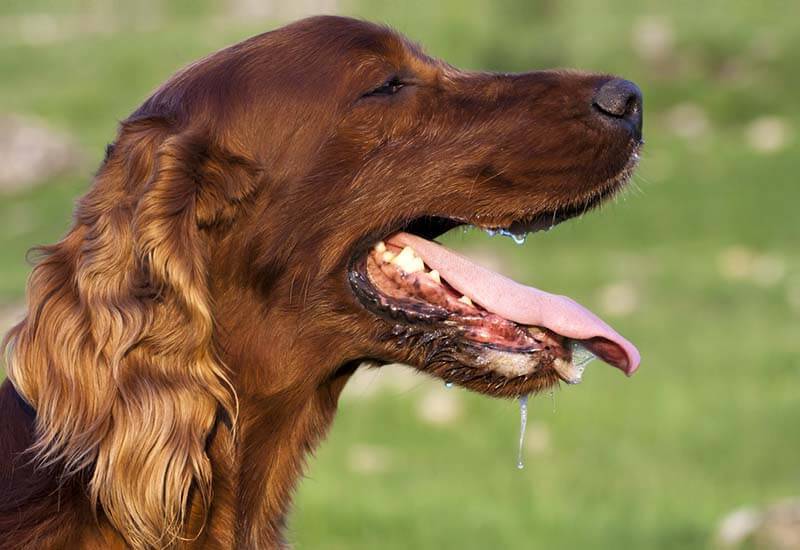
Enlargement of the abdomen
The abdomen may increase dramatically in size due to the swelling of the stomach. Or gradually – due to pregnancy, excess body weight or accumulation of fluid in the abdominal cavity. In any case, under these conditions, the organs in the abdomen will be squeezed and put pressure on the diaphragm, the pet will have shortness of breath.
Mucosal discoloration
The gums, tongue and mucous membranes of the eyes should normally be light pink or pink in color in a dog. If the blood slowly enters the mucous membranes, it is not sufficiently saturated with oxygen, and the mucous membranes change their color. With the development of heart failure, they turn white, with respiratory failure, they become bluish or grayish.
Diagnostics
First of all, when contacting the clinic, the doctor at the reception will examine the nose and oral cavity. Assess the respiratory rate and heart rate. Will take the temperature and perform auscultation (listen to the dog). Most often, after these procedures, the cause of shortness of breath will become clear. However, there are situations when additional examinations are required:
An x-ray is needed in order to assess the chest cavity for the presence of formations, the tissue of the lungs and bronchi – for the presence of foreign bodies, the chest cavity – for the presence of fluid and the size of the heart.
Clinical and biochemical blood tests are necessary to assess inflammatory processes, the functioning of internal organs – the liver, kidneys, and to detect anemia.
Ultrasound of the heart. Find out if there will be murmurs in the heart valves during auscultation, and if the size of the heart will be normal.
In severe cases, other tests are also prescribed – MRI, CT, examination for infections, a complete medical examination of the dog.
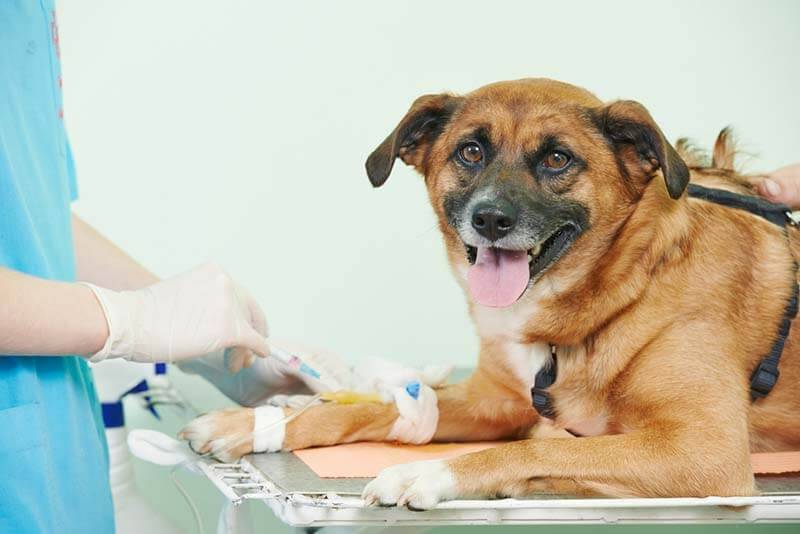
Treatment
It must be remembered that shortness of breath is not a disease, but only a symptom. Therefore, treatment should be aimed at eliminating the cause of frequent breathing.
RџSЂRё development of diseases of the cardiovascular systemTherapy is aimed at maintaining the heart muscle, diuretics and pressure control are prescribed.
If the problem is related to airway patency, the doctor will remove the foreign body and restore breathing. With the development inflammatory processes extended antibiotic therapy is prescribed, as well as drugs to maintain immunity. At electrolyte imbalance, as in canine eclampsiaprescribe calcium and other trace elements.
Stress management also plays an important role in therapy. Dogs are prescribed sedatives, in addition, saturation of the lungs with oxygen in the oxygen chamber is shown.
Puppy breathing fast
In young dogs, all processes in the body proceed at a faster rate, so frequent breathing in a puppy is rather a variant of the norm.
The puppy gets tired faster and recovers faster after physical exertion and heat.
Of course, the most common reason why a puppy is panting is because of hyperactivity and overwhelmed emotions. He, like a child, rejoices in new toys, the first walk, is hard going through the absence of the owner.

If an operative visit to the veterinarian is not possible
If the dog is breathing rapidly and often, shaking, trembling, but you cannot urgently consult a doctor:
provide complete rest to the pet, if possible, remove all stress factors;
the room in which the dog is located should be cool and well ventilated;
a cool towel applied to the head and a fan on may be helpful to lower the temperature;
bathing your pet in a cold shower is not recommended due to the risk of a sudden drop in temperature and causing even more stress! Better to use cool water.
Prevention
Diseases of the respiratory system of a dog, manifested by rapid breathing, can pose a serious threat to the life of a pet, therefore, it is necessary to take all possible measures to avoid this. The main rules of prevention include the following:
Do not overload the dog in the heat, do not leave it in the open sun or in the car.
Get regular check-ups, including heart check-ups. For large breed dogs, this is especially important at any age, for small breeds – from the age of 6 years.
Stressed dogs should be given sedatives in advance – before moving, holidays, guests, fireworks.
Treat the animal for parasites. There are helminths that develop in the lungs and can cause chronic inflammation and changes in the bronchi.
Vaccination is one of the simplest and most reliable ways to prevent many diseases in dogs. Keep in mind that this is an annual procedure.
Answers to frequently asked questions



